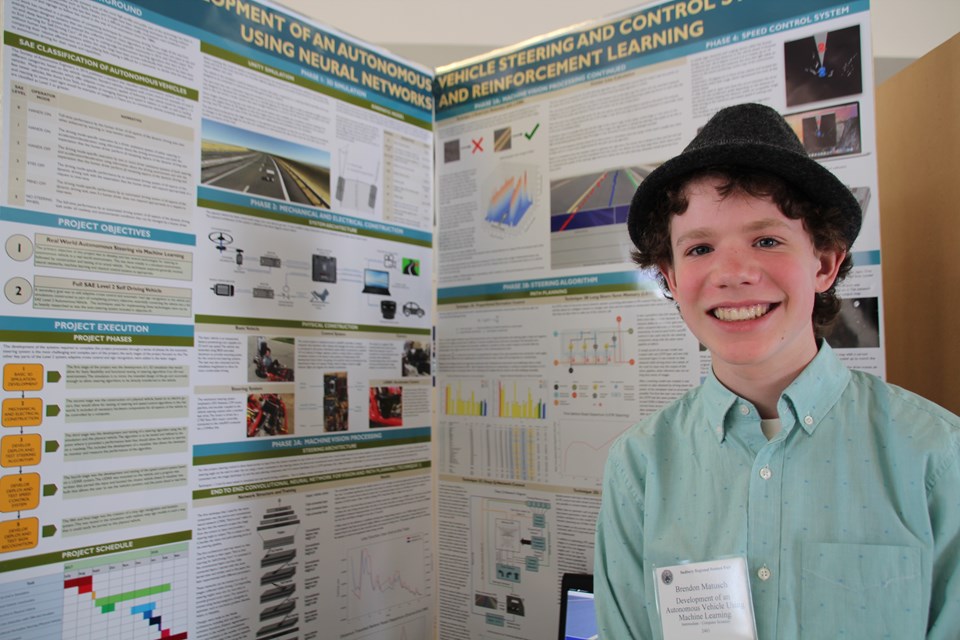Local student, Brendon Matusch on his time at SNOLAB

Hello! My name is Brendon Matusch. I’m a 15-year-old aspiring software engineer, with an interest in physics, automation, and machine learning technologies. I’m here to tell you a bit about the summer I spent at SNOLAB working on the PICO-60 and DEAP-3600 dark matter projects, what I learned, and where I plan to go in the future.
First off, a bit of background. Between the summer of 2017 and the spring of 2018, I developed an autonomous vehicle based on an electric go-kart, using neural networks and reinforcement learning. I went on to compete at the Canada-Wide Science Fair (CWSF) in May 2018 with my research on that project (my third time at CWSF) and, to my great surprise, was honored with the Best Project award.
After returning home, I began thinking about my next project. I have long been fascinated by astrophysics and particle physics, so when I got the opportunity to talk to Dr. Nigel Smith about possible applications for deep learning at SNOLAB, I was more than a little enthusiastic. The competitions that take place between deep learning researchers, using data from labs such as CERN, show that these technologies present significant value to the world of physics, and I was excited to see how I could use deep learning to contribute to projects at SNOLAB.
I started by working to develop a system for separating alpha particle events from nuclear recoil events using data from the PICO-60 bubble chamber experiment. I created a general deep learning system, using semi-supervised learning, that can learn to separate particle types using a small labeled data set. I developed this in the context of PICO-60, but it can generalize to almost any kind of experiment.
First, I experimented with several different formats of data to be used as input to neural network models. Expanding upon the banded frequency data used in the initial analysis, I applied higher-resolution frequency data, raw audio waveforms, and even the images captured by cameras in the PICO-60 apparatus.
Second, I applied these input formats in the context of semi-supervised learning, in which a small labeled data set is used alongside an additional unlabeled data set. I developed and validated 2 different original algorithms for this: iterative cluster nucleation and gravitational differentiation, both of which share the goal of improving data efficiency.
My system improved upon the neural network applied in the original PICO-60 paper, and is competitive with the manually tuned Acoustic Parameter technique. I also applied the same system to predict the nuclear decay from which an alpha particle event originates and got quite good performance using only 30 training examples. These are great signs for the applicability of machine learning in this class of experiments, and I’m optimistic to see how it will work on upcoming projects!
I would like to very sincerely thank Dr. Ken Clark, Dr. Carsten Krauss, and Dr. Scott Fallows for giving me the guidance and data I needed to get started on this, and for putting up with my multitude of questions. I couldn’t have asked for a more supportive team, and I’m glad I could develop some tools that may be useful to them in the future.
I also got the opportunity to also work on the DEAP-3600 project! Here, the challenge was to identify events that occurred in the neck of the detector, and could not be picked out with conventional position reconstruction. In the context of data from the Monte Carlo simulation, I’ve managed to do this quite successfully, and I’m continuing to work on doing this more efficiently using simpler neural network models. The resulting neural networks have generalized in a rather unexpected way onto the real-world data, which may provide a useful result for the simulation team.
Thanks very much to Dr. Pierre Gorel, Dr. Eric Vazquez-Jáuregui, and Dr. Rob Stainforth for giving me access to the data and helping me understand how the experiment works as a whole!
It’s been a stressful but awesome summer working on these projects. While at SNOLAB, I also got opportunities to join the International Summer School for Young Physicists (ISSYP) for a day of physics lectures, to listen to the presentations done by other interns at SNOLAB, and to go into the cleanroom and see the PICO40L detector under construction (although I’m too young to go underground)!
Now, what are the next steps for my project? I’ve written a research paper on my work with PICO-60, which is currently undergoing review by the collaboration. Further down the road, I plan to return to the science fair. I’m going to apply to be one of the eight members of Team Canada at the Intel International Science and Engineering Fair (ISEF) in May 2019.
If I am accepted, it will be my second time on Team Canada (after my experience at the European Union Contest for Young Scientists last month, in which I, as well as Nicolas Fedrigo of Victoria, BC, were honored with two of the three First Prize awards). If not, I will return to the Canada-Wide Science Fair in 2019. I hope to represent Sudbury and SNOLAB well!
No matter where I go in the future, I will always remember this summer as a great experience in which I learned a tremendous amount and very much enjoyed the opportunity to contribute something to the world of physics. Thanks to everyone who guided me along the way, and I’m excited to see what the future brings!